What Is The Different Types Of Service Animals
Living with any kind of disability is hard, merely it can be easier with aid from a service domestic dog. There are many different types of service dogs , with specific tasks and legal rights.
Keep reading to acquire more than about the best service canis familiaris breeds and how they can help people with disabilities.
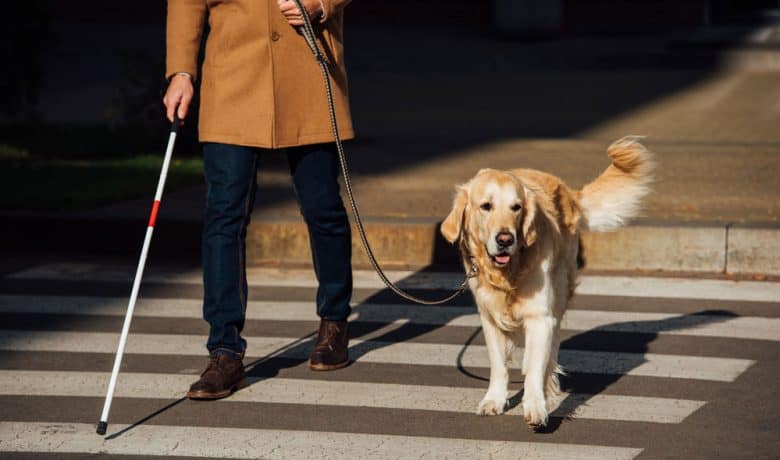
What is a Service Dog?
Dogs take been our all-time friends for a long time. The mix of empathy, loyalty, and hard work is why dogs are the only animals that authorize equally service animals.
According to the Americans with Disabilities Act (ADA), a service dog is divers as a dog "trained to perform tasks for a disabled individual who would otherwise have problem completing those tasks."
People with physical or sensory disabilities, and intellectual, psychiatric, or other mental disabilities qualify for a service dog.
What Makes a Practiced Service Canis familiaris and Which Breeds are Best at It?
Next to the intelligence needed for circuitous tasks, skilful service dogs have a calm demeanor. They besides need a stiff piece of work drive and a tendency to bond strongly with their human partner.
Here are the best service domestic dog breeds:
- German Shepherds
- Labrador Retrievers
- Golden Retrievers
- Poodles
- Great Danes
- Boxers
- Pomeranians
- Border Collies
- Pitt Bulls
- Bernese Mountain Dogs
Different types of service dogs and what they practise
The most common type of service dog is a guide domestic dog. Guide dogs help bullheaded people in their everyday activities and walking effectually public spaces.
Other types of service dogs are hearing dogs, mobility assistance dogs, seizure alert dogs, autism help dogs, psychiatric dogs, etc.
You lot can see some of the tasks that service dogs perform in this video:
Full general Service Dogs
one. Mobility Assistance Dogs
Also known equally brace/mobility support dogs (BMSD), these dogs aid people with mobility problems. These bug are often caused by brain injuries, spinal string injuries, and arthritis.
They can perform various tasks similar pulling wheelchairs, retrieving objects, opening/closing doors, pressing buttons and light switches, etc.
These dogs also provide balance or bracing to handlers with residuum bug. Nearly BMSDs article of clothing a special harness.
Only large breeds can be mobility assistance dogs since they need to back up the weight of their partner. Golden Retrievers, Labradors, Rough Collies, and Samoyeds are normally used for this chore.
Guide Dogs
2. Seeing Centre Dogs
Seeing eye dogs or visual help dogs lead and aid blind people and people with visual impairments. Attempts to train dogs to assist the blind have been going on for centuries.
However, the modern history of guide dogs started during the First Globe War in Germany.
Dog training of guide dogs is extensive and it tin can final for 14-xviii months. These dogs acquire how to avoid overhead obstacles, stop at curbs, and help their handler find door handles, among other things.
They are also trained to disobey commands that could put their handler in danger.
The most mutual seeing eye dogs are Labradors, Golden Retrievers, German language Shepherds, and Poodles.
iii. Hearing Dogs
Hearing dogs are trained to alarm deaf or hearing impaired people to various noises and sounds.
They alarm their handlers by touching them and leading them towards the noises similar smoke alarms, alert clocks, doorbells, door knocks, ringing phones, crying babies, etc.
Once once again, Labradors and Aureate Retrievers lead the mode. Other suitable breeds include Cocker Spaniels, Poodles, Lhasa Apsos, Shih Tzus, and Chihuahuas.
Medical Assistance Dogs
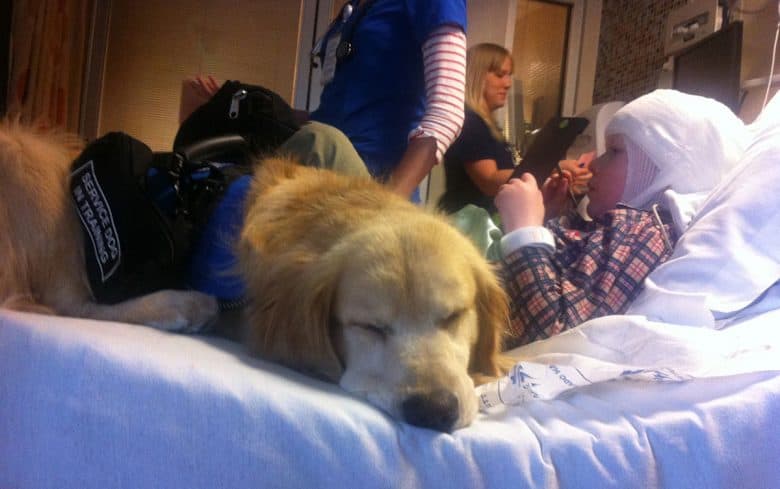
four. Psychiatric Service Dogs / Social Feet Dogs / PTSD Service Dogs
Psychiatric service dogs assist people suffering from various mental health problems, such equally depression, social anxiety, and postal service-traumatic stress disorder (PTSD).
Their primary function is to maintain their handler's emotional land.
PTSD is the nigh common mental wellness affliction that requires the help of a service dog. It oftentimes affects people that accept served in combat or equally first responders.
However, PTSD can be acquired past other life-threatening events like terrorism, natural disasters, or a car crash.
These dogs can calm downward people with PTSD when they feel flashbacks. They besides provide physical comfort and emotional back up during panic attacks or feet attacks.
They are trained to enter a room before their handler, plough on the lights for them, and create a barrier betwixt their man and other people in public.
Psychiatric service dogs take to be reliable, calm, intelligent, cooperative, and eager to please. Labrador Retrievers, Poodles, Havanese, Schnauzers, Boxers, and German Shepherds are the most reliable psychiatric service dogs.
5. Autism Support Dogs / Autism Service Dogs
Autism service dogs are trained to help children and adults on the autism spectrum. They tin can stop harmful behavior, warning the handler to certain noises, and alert parents of autistic children to dangerous situations.
For children on the autism spectrum, including kids with less astringent conditions like Asperger'southward, service dogs can provide confidence in social situations and help them connect with other children.
Labradors and Golden Retrievers are most commonly used as autism support dogs. Other breeds such as German Shepherds, Saint Bernards, Beagles, Crude Collies are also suitable for the job.
6. Seizure Alarm and Response Dogs
Seizure response dogs assist people during or later seizures. Meanwhile, whether the dogs can be trained to predict oncoming seizures is debatable.
Some neurology experts claim that they can't. Other inquiry suggests that dogs tin can smell upcoming seizures.
In any example, seizure response dogs are crucial for people with epilepsy. Their job is to activate an emergency response alarm, retrieve medication or phone, and get someone to assistance during the seizure.
They can even remove their handler from a route or another dangerous place or state of affairs.
Larger breeds like Golden Retrievers, Labs, German Shepherds, Border Collies, and Samoyeds are suitable for this work.
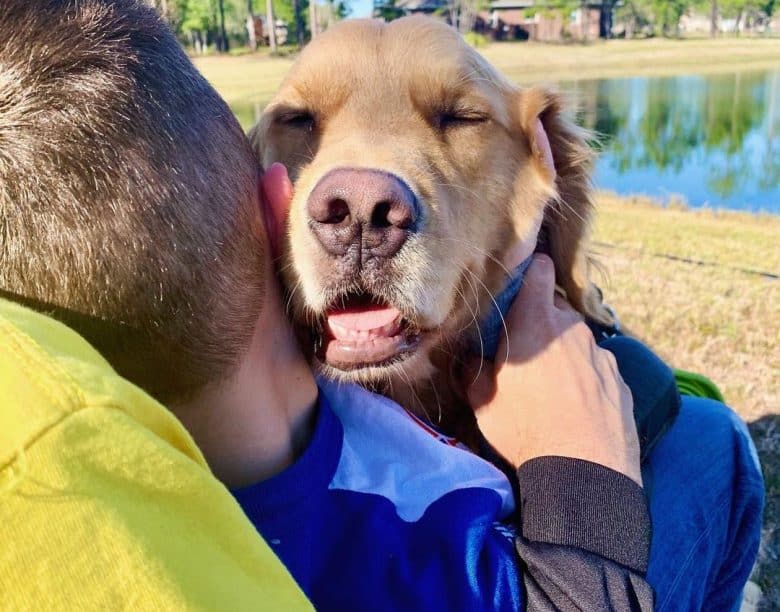
7. Sensory Indicate (Social Signal) Dogs
Sensory indicate dogs are similar to autism service dogs since they are also trained to help people on the autism spectrum. They can interrupt their handler when they engage in repetitive or self-injurious behavior.
8. Allergy Alert Dogs / Allergy Detection Dogs
Allergy alert dogs (AADs) help people with astringent allergies by sniffing out the smallest traces of allergens that could cause an anaphylactic stupor.
Any dog breed tin can become an allergy alert dog if they have an extraordinary sense of odor.
They are by and large paired with children to proceed them away from allergens such as milk, eggs, peanuts, and wheat.
9. Diabetic Warning Dogs (DADs)
Diabetic alert dogs are a type of medical warning service dog. They are trained to alert their humans to blood sugar changes since they tin can sense high or depression blood glucose levels past scent.
If a blood exam confirms these changes, the handler will inject insulin or take a dose of glucose.
10. FASD Service Dogs
FASD service dogs support children with fetal alcohol spectrum disorders, which are acquired by prenatal exposure to alcohol.
These kids can accept a range of physical and mental bug, behavioral problems, and learning disabilities.
FASD service dogs are trained similarly to autism support dogs, including their ability to interrupt repetitive or self-harming behavior.
Ofttimes Asked Questions Nigh Service Dogs
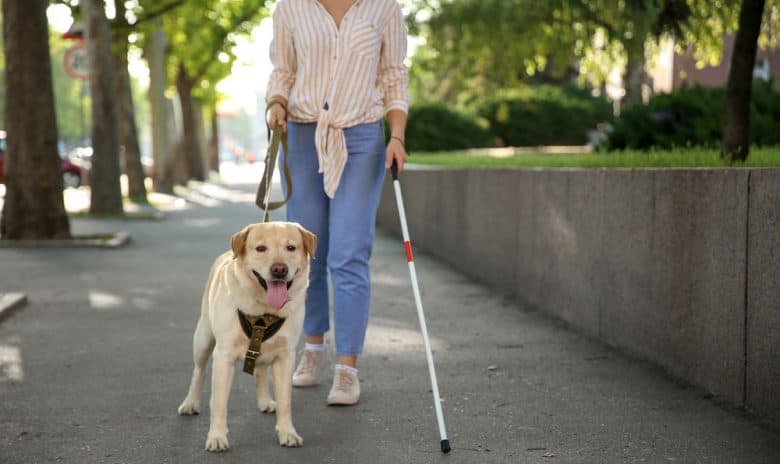
What rights do service dogs have?
Service dogs have full public access rights, allowing them to go into public places where other animals can't, such as restaurants, libraries, stores, etc.
They are also allowed in housing or public transport of whatsoever kind, including airplanes.
Is there a difference between service dogs and working dogs?
Service dogs and working dogs are pretty similar since they both accept specific tasks. In general, working dogs can perform more tasks, often related to their sense of scent.
Some tasks that working dogs perform include search and rescue, explosives or cancer detection, police force and military work, herding, hunting, and others. Allergy alert dogs are sometimes classified as working dogs.
What is the difference betwixt service dogs and therapy dogs?
Therapy dogs don't have a unmarried, specific handler. Instead, they volunteer in public settings, like hospitals, hospices, mental wellness institutions, nursing homes, and schools.
Their task is to provide condolement and amore to anyone who needs it.
Breeds that have a calm demeanor and easily bear witness affection to people are suitable to being therapy dogs.
That includes Golden Retrievers, Labrador Retrievers, Poodles, Pugs, Greyhounds, Pomeranians, German Shepherds, Beagles, and many others.
Although therapy dogs tin be quite helpful, they don't have any legal rights, including public access rights.
If you want to volunteer and experience that your dog could be a proficient therapy dog, contact the Brotherhood of Therapy Dogs for guidelines. The AKC Canine Good Citizen (CGC) program provides a grooming program for therapy dogs.
What practise emotional back up animals (ESAs) practise?
Emotional support animals, including emotional support dogs, are dissimilar from service dogs. While they oft have one handler, they aren't trained for specific duties and tasks.
Notwithstanding, ESAs can help people with depression, anxiety, panic attacks , and various phobias. A mental health professional must prescribe an emotional support domestic dog to the patient.
ESAs have express legal rights. Under the Fair Housing Act, they have a right to "reasonable accommodations" in buildings that don't allow pets.
Emotional support animals were as well allowed on flights until recently, just airlines accept the pick to refuse access to ESAs now.
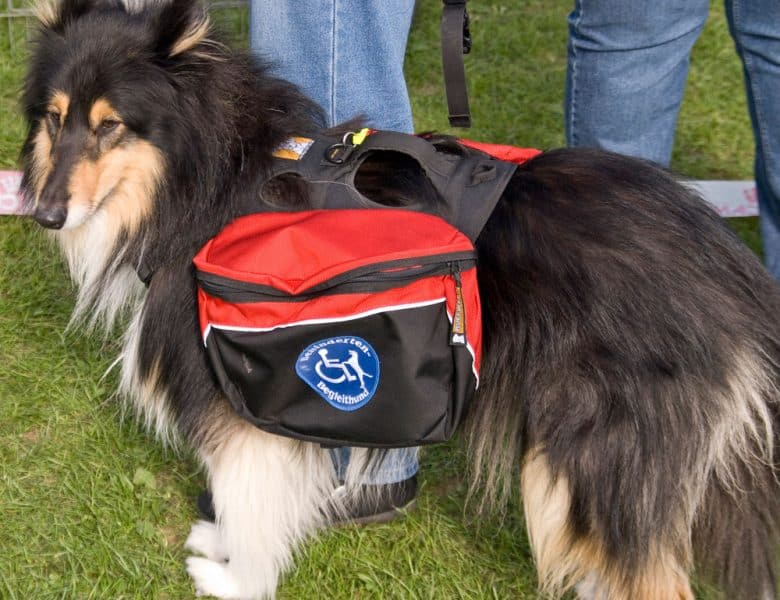
How to know if your dog can be a service dog?
Any dog can become a service canis familiaris, but small breeds may not be suitable for jobs that require forcefulness and size.
Before a dog tin become a service dog, information technology has to go through rigorous preparation. While you can train the dog yourself, it is best to rent a dog trainer.
In the USA, it is non necessary to certify service dogs.
To confirm that your dog is ready to have on his duties, he should pass the Public Access Certification Test (PACT), constitute on the website of Assistance Dogs International.
You lot can learn more about the public access exam for service dogs on this website.
How to choose a service dog?
As we already mentioned, any canis familiaris tin can become a service dog later training. If y'all are looking for a service dog to train, cull a suitable breed for your inability.
If you don't already own a dog that you want to train, check out service canis familiaris organizations in your area for help. If necessary, y'all tin have more than one service domestic dog.
Who determines whether you lot need a service dog?
People with disabilities determine whether they need a service dog. Nevertheless, a medico or a mental health practiced can recommend it.
Conclusion: Should Y'all Get a Service Dog?
Training a service canis familiaris requires a lot of time and effort. At the very least, it can be costly to rent a professional trainer.
However, service dogs can provide invaluable help and improve the quality of life of people with disabilities.
Do you take a service dog, or do you plan to use one in the future? Share your experience in the comments.
Further reading: Other canis familiaris breeds to bank check out
- All-time Canis familiaris Breeds for Beginning-Fourth dimension Owners
- Best Canis familiaris Breeds for Apartments
Source: https://www.k9web.com/dog-training/types-of-service-dogs/
Posted by: sanchezinviand92.blogspot.com


0 Response to "What Is The Different Types Of Service Animals"
Post a Comment